|
Canadian
wine
Visiting wine country in Ontario, part 1, an introduction
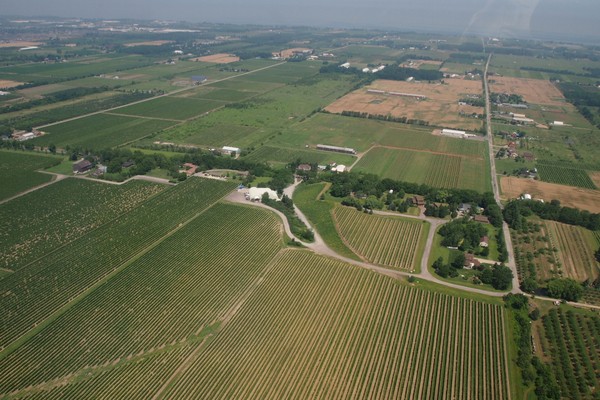
Niagara vineyards from the air,
looking towards Lake Ontario
Canadian wine? To be honest, it was
pretty much off my radar, until I visited for the first time in July
this year. My only Canadian wine experience until then had been
their most famous export: Ice Wine. But, as I discovered on my trip,
there’s a lot more to Canadian wine than this. Indeed, on this
trip, I tasted just one ice wine.
I was visiting Ontario wine country. Put
simply, Canada has two major wine regions, 3500 km apart. To the
east of the country, within a couple of hours’ drive of Toronto, there are
the vineyards of Ontario, and here there are two main regions,
Niagara and Prince Edward County. Then on the west, there are the
vineyards of British Colombia (BC), which I didn’t visit, but I
will try to
get to next year. Both Ontario and BC produce similar quantities of
wine.
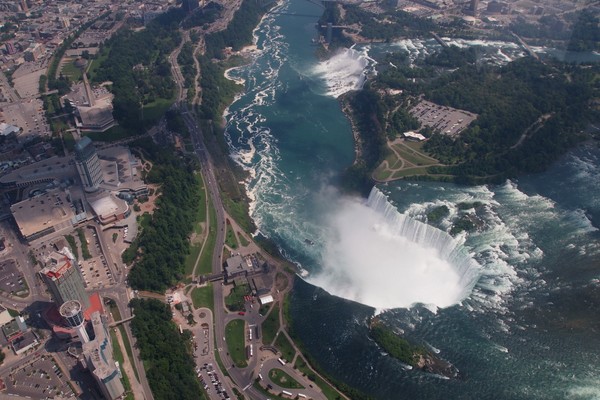
What
happens when a large river goes over the Niagara escarpment: the
famous falls
I was in for a number of surprises.
The first was the scale of the wine
industry here. It’s actually quite big, and has recently grown
substantially. In 1995 there were around 40 wineries in Niagara; now
there are over 200. Having a metropolitan area with 5 million people
in easy striking distance of wine country means there’s strong
local demand for the wines. This reduces the pressure to export,
which is one of the reasons people like me weren’t really aware of
Canadian wines, with the exception of the ice wines which have found
their way abroad.
The second was the climate. It’s not
actually all that 'cool climate'. The winters are cold here, of course
– and quite long. But once summer gets going it can be pretty hot. In
Niagara, heat summation in terms of growing degree days, is 1400.
That means it’s warmer than Burgundy (1315), and not all that far
off Napa (1450). Prince Edward County is cooler, at around 1260.
The big influence on climate here is the
presence of very large lakes, and specifically Lake Ontario for the
regions I visited. Proximity to the lake moderates the extremes of
temperatures. The closer you are to the water, the cooler the highs and the lower
the winter lows. So there’s a sweetspot, just a little away from
the water, where early season frost risk is mitigated, and you get
enough warmth to ripen your grapes.
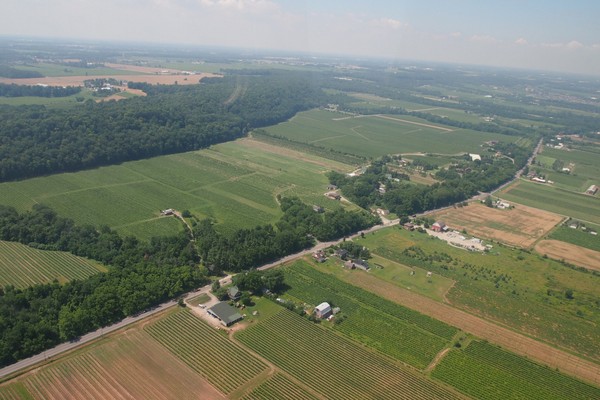
Many of the vineyards here have frost
fans, but these aren’t just for spring frost: they’re also for
combating the real winter lows, and are turned on when the air
temperature hits –18 °C. Fruiting buds can be damaged by
temperatures in the range –15 to –20 °C, and below about –22
°C the vines can be seriously damaged by the cold. In the cooler Prince Edward
County, it’s necessary to bury the vines over winter. This means
that they have to be trellised incredibly low to the ground.
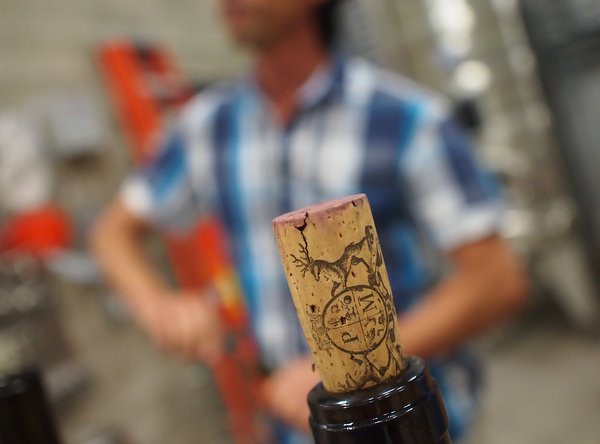
Although it's not all that cool, the climate in Ontario is challenging
for winegrowing. Disease pressure is high because of the warm, humid
conditions during summer, and the occasional heavy rains. While I
was visiting, there was a massive thunderstorm, with some vineyards
experiencing hail damage. It’s pretty tough for organic or
biodynamic winegrowers here, and there are a few of them. ‘It’s very
extreme viticulture,’ says Francois Morissette of Pearl Morissette,
one of the top wineries in the region. ‘You have to be extremely
adaptable.’
Some geology. In Niagara, the vineyards
are planted between the Niagara Escarpment and the lake shore. The
escarpment was formed by glacial erosion, and it’s a ridge that
rises up to 90 metres above the shoreline, providing the gentle
slopes that are a feature of the region. With many of the
sub-regional names, you’ll come across the term ‘bench’. These
are the areas of land under the escarpment. Because of the
successive glacial erosions, there is a diversity of soil types in
Niagara.
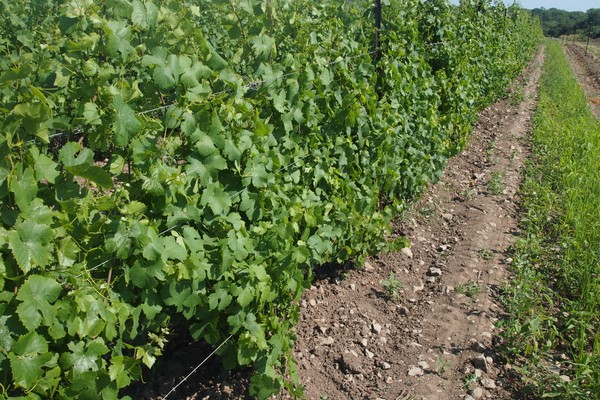
Vines
in Prince Edward County
Prince Edward County is Ontario’s most
northerly region, and one of the newest, established as an
appellation as recently as 2007. The County is practically an
island, jutting out into the eastern end of Lake Ontario. There’s
a real buzz here. It’s quite a bit cooler than Niagara, and has
limestone bedrock and stony soils, which make for a great
combination. When things go right, the results make it worth all the
stress of dealing with such a marginal climate.
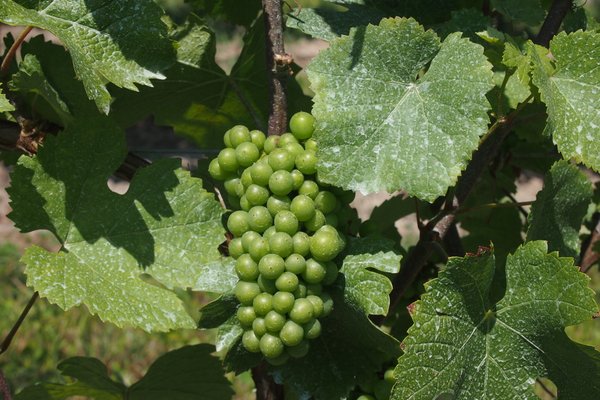
The appellation system here is known as
VQA, which stands for Vintners Quality Alliance. [This applies to
Niagara and Ontario, not other Canadian wine regions, which are
small, anyway.] In Niagara, there
are three tiers of appellations (three regional, and then 10 sub
appellations, with 7 of these in two collective subappellations),
and in British Columbia there are five regional appellations and no
subappellations. And this is where I have my first of two gripes
about the Canadian wine industry. Obtaining
VQA for your wines is vital, because there is a tax break of some
20% if you get VQA, so it is financially very damaging not to get
it. And you can fail on a taste test if a group of worthy people
decide they don’t like your wine, for example because it lacks ‘typicity’.
This has happened to one winegrower I met, and the wine that failed
is fabulous. This isn’t fair. It’s also nuts: it could end up
stifling the development of interesting Canadian wine, because
winemakers can’t risk failing the VQA. The Canadian wine industry
is far too young for people to start deciding what is typical or
not. In Europe, it’s common for top wines to be sold as the
equivalent of IGP or table wine because they are refused the AOP,
but this isn’t so much of a problem for European growers: with the VQA, it is the
associated tax break that is the killer. There needs to be a way for
winegrowers to declassify their wines if need be without being
penalized financially.
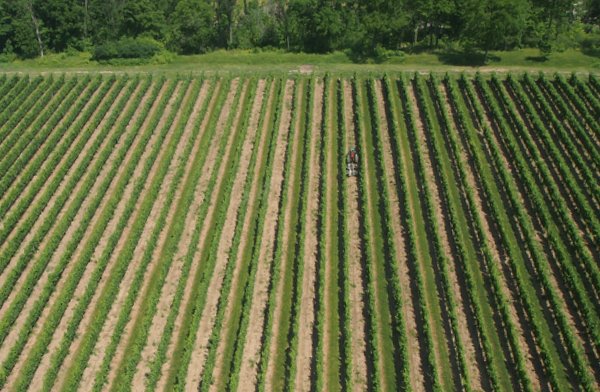
The other issue with Canadian wine is the
incredibly dubious but highly profitable category known as
International–Canadian Blends (ICBs). Here you have well known
Canadian wineries who are allowed to blend in bulk-shipped wine from
abroad with a bit of Canadian wine, and then put them on the shelf
as if they were Canadian wine. In Ontario, there has to be 40%
Canadian wine in the blend, with a minimum of 25% Ontario wine.
There’s also a label designation called Product of Canada, and
these wines are allowed to have 25% of imported wine in them.
Before 2010, these ICB wines used to have
‘Cellared in Canada’ on the label, which was even worse.
According to stats on the Winery and Grower Alliance of Ontario,
ICBs represent 73% of all Ontario wine sold. 54% of the grapes
harvested in Ontario are destined for these ICBs.
By international wine standards, ICBs are
an embarrassment to the Canadian wine industry. I couldn’t believe
it when I heard about them and saw them on the shelf. ICB as a
category is a historical artefact, and now the Canadian wine
industry is growing and developing, it’s time that these wines
were labelled honestly. There is nothing wrong with importing bulk
wine and bottling it in Canada, but label integrity standards the
world over should be adhered to: the wine label should make it clear
where the wine comes from. The
big companies who make lots of money from ICB claim that it helps
make the Canadian wine industry sustainable - but at the cost of
label integrity?
There’s a really good explanation of
the whole messy situation here. http://www.grapegrowersofontario.com/node/68
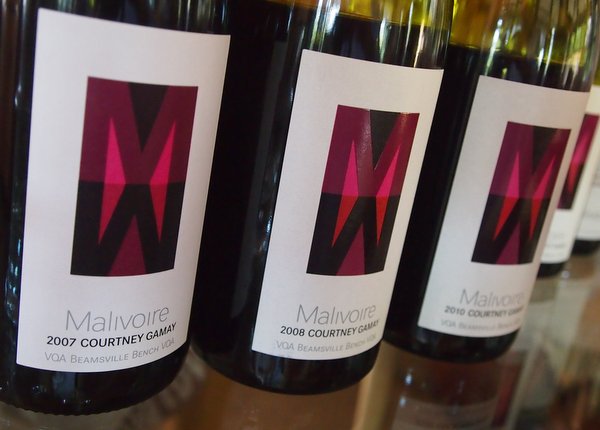
But enough of the griping. Back to the
wines. I was taken aback by just how good the top Canadian wines
are. For reds, Cabernet Franc is the surprise star, supported by
Gamay and Pinot Noir. 'Cabernet Franc is our unsung her,' says Paul
Pender, winemaker at Tawse. 'It's a misunderstood grape.' For
whites, Chardonnay is the most widely planted variety, and the best
ones are superb, although too many are a little warm and rich in
style. Riesling is also impressive. I’m going to be writing up all
my visits in full over the next few weeks, and I’ll also be adding
all the notes I took during the i4C cool climate Chardonnay
conference that I finished the trip with.
VISITING
ONTARIO WINE COUNTRY, CANADA
NIAGARA
 Southbrook Southbrook
 Malivoire Malivoire
 Tawse Tawse
 Pearl Morissette Pearl Morissette
 Bachelder Bachelder
 Hidden Bench Hidden Bench
 Ravine Ravine
PRINCE
EDWARD COUNTY, CANADA
 Hinterland Hinterland
 Closson
Chase Closson
Chase
 Huff
Estates Huff
Estates
 Rosehall
Run Rosehall
Run
 Norman
Hardie Norman
Hardie
Wines
tasted 07/13
Find these wines with wine-searcher.com
Back
to top
|

